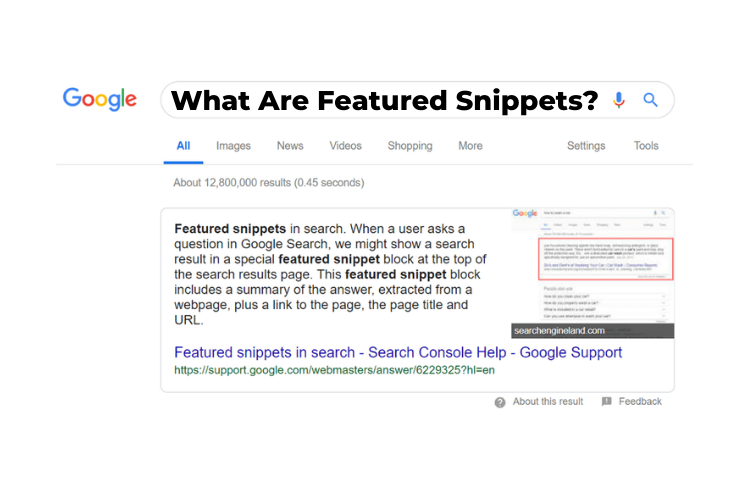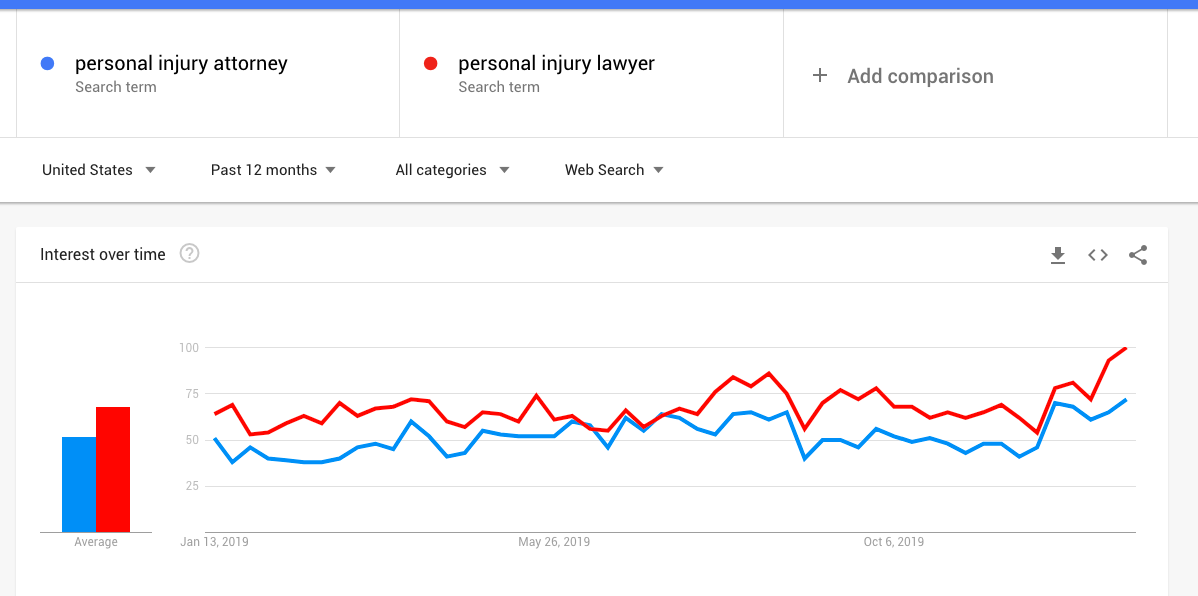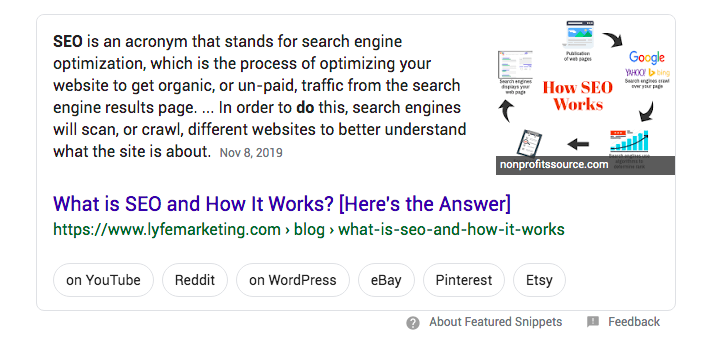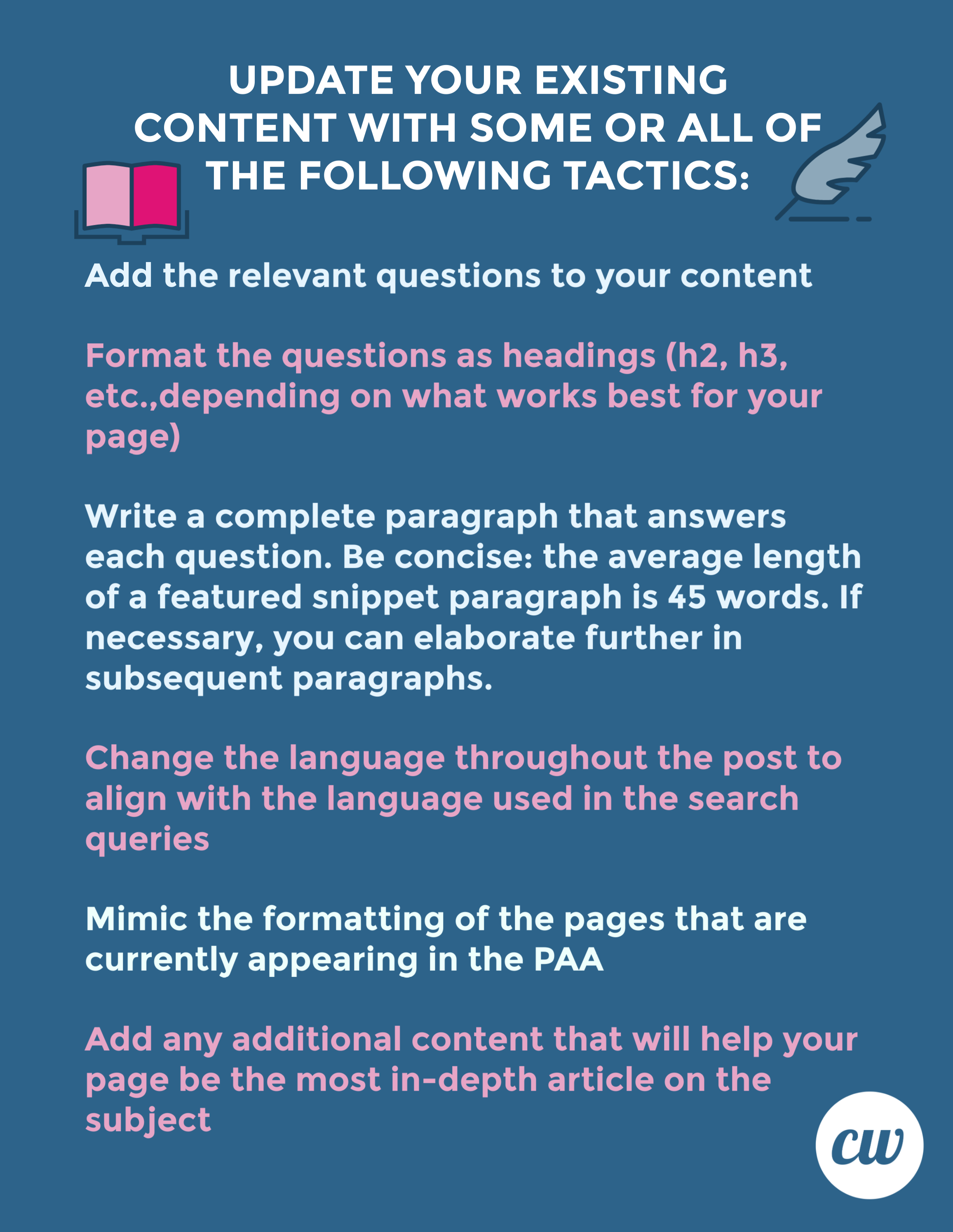
What Are Featured Snippets?
If you’re a regular user of Google’s search engine, you’ve likely noticed that the information displayed on its search engine results pages (SERPs) is constantly evolving to meet Google’s mission to “organize the world’s information and make it universally accessible and useful.” Features such as knowledge graphs, People Also Ask boxes, and featured snippets have changed the face of SEO strategy.
In 2014, Google introduced featured snippets, which have since become a key SEO consideration. If you aren’t already optimizing your content to account for featured snippets, you could be missing out on significant web traffic.
Let’s take a closer look at featured snippets and how to effectively incorporate them into your content marketing strategy.
What Are Featured Snippets?
Featured snippets are selected search results that appear at the top of organic results and below ads. They include descriptive text that Google believes will help users “more easily discover what they’re seeking.” Featured snippets typically answer the search query directly on the SERP, without requiring the user to click through to the website. You may also hear featured snippets referred to as “position zero” because they appear above the first organic position. They’re also sometimes referred to as “answer boxes,” because the information is displayed inside a box.

You can easily recognize featured snippets because the format is reversed: instead of the page name followed by a description, featured snippets show the description first. Featured snippets may display paragraph content, a list, or even a video.
Featured snippets were introduced in part to address the increase in mobile and voice searches. Mobile search traffic has surpassed desktop search traffic, and more people are also conducting voice queries on their mobile devices. For these users, Google determined that featured snippets would be more useful than its traditional model of ten blue links.
Featured Snippets Drive Traffic
When featured snippets were first introduced, content publishers were worried that their traffic would suffer. If a user could get all of the information they need from the featured description, would they still click through to the website?
However, Google has confirmed that featured snippets do drive traffic to websites, and increasing your chances of gaining a coveted featured snippet position can provide a big boost to your SEO. Research supports this claim: Search Engine Land reports how optimizing content to rank for a featured snippet — adding question-based and user-focused content, and making content longer and more in-depth — led to a 516% increase in sessions.
How to Get a Featured Snippet
So how can you rank for a featured snippet? The foundations of good SEO still apply: create high-quality content, optimize your content for the right keywords, obtain backlinks from other websites with high domain authority, and provide a good user experience.
Research by Ahrefs indicates that 99.58% of featured snippets come from pages that are already ranking in the top 10 search results. But, those pages aren’t necessarily ranking in the #1 position. STAT reports that 70% of featured snippets come from pages outside the first organic position. That means with a well-executed featured snippet strategy, you could leapfrog the competition and get your website higher on the SERP.
The site that appears most often in featured snippets is Wikipedia, so if there’s a Wikipedia entry for your targeted search query, that may be hard to beat. But a careful examination of other websites appearing in featured snippets could provide valuable insight into how to optimize your own content.
Start with keyword research
Just like when you’re optimizing your content for organic search results, start with the right keywords.
Google Trends is a great tool for discovering trending search queries. You can also look at your website’s top queries in Google Search Console to get an idea of what sort of information your audience is looking for.

Use long-tail keywords
Most featured snippets are triggered by long-tail keywords. In fact, the more words a search query contains, the more likely it is to generate a featured snippet.
Try it yourself: If you search for “SEO,” you’ll probably see Moz’s Beginner’s Guide to SEO at the top of the page, followed by organic results from other highly authoritative websites such as Search Engine Land, Wikipedia, and Google itself.

But if you search for “how does SEO work,” you’ll see a featured snippet from an article by Lyfe Marketing, a digital marketing company based in Atlanta, GA. Lyfe Marketing has done such a good job of optimizing their content for this long-tail search query that they’ve managed to appear above websites such as Moz and Search Engine Journal.

Focus on question-based queries
When performing keyword research to target featured snippets, focus on search queries formatted as questions. Many users type complete questions into search queries, and these queries are easy to identify and answer.
Use keyword tools such as Answer the Public to identify a list of questions related to your topic. For example, if you enter the query “how does SEO work,” you’ll see a list of related questions starting with how, what, where, which, who, when, and why.
Look at the People Also Ask box
Another SERP result that is closely related to featured snippets is the People Also Ask (PAA) box.
PAA boxes first appeared in 2015 and now show up on 93.8% of SERPs with featured snippets. These boxes can provide tremendous insight into the kind of information people are searching for.
PAA boxes may appear in different places on the results page; sometimes they’re under the first organic result, and sometimes they’re further down the page. These boxes show other questions related to the initial query.
Here’s an example of a PAA box for the search query “how to find the right content writer”:

PAAs can trigger a potentially unlimited number of related queries; when you click on one, 3-4 additional queries appear in the list.
There are some important points to understand about PAA questions. PAA questions may trigger their own featured snippets. Different queries may trigger the same PAA question with the same result. And, the answer that appears under a PAA question may also appear under a different PAA question.
As you identify your long-tail keywords, it’s worth spending some time looking at PAA questions and answers. There are several tools, such as STAT, that can help you scrape PAAs and show you the exact rankings of URLs in the PAA box.
Evaluate the competition
Spend some time reviewing the results that appear for both featured snippets and PAA boxes. Can you do a better job with your content? You may find that a featured snippet result doesn’t necessarily contain the most comprehensive content; it just does a good job of answering the search query. Look for opportunities where you can provide more in-depth content, a more comprehensive list, more industry insight, or other additional value.
Answer questions in your content
Finally, take the list of questions you identified from Google Trends, Answer the Public, and People Also Ask boxes, and write content that answers those questions. Depending on your findings, this may involve developing new content, or re-optimizing the existing content on your site. If you already have content on your website related to the topic, a few simple updates may give you a chance at ranking for a featured snippet or a PAA box.
Start with content that you’re already ranking for. These pages will be the easiest to optimize.

Answer several questions in one article. The same page can rank for different featured snippets or PAA results. And, once a page is featured, it’s more likely to show up for similar queries. Google is very good at recognizing related queries, so there’s no need to create a separate post for every question on your list.
Create highly structured content
Google loves structured content, whether that means a list, a comparison chart, or a sequence of numbered steps. Featured snippets often show a list of items, the ingredients for a recipe, or the number of steps to complete a task.
Content with this type of question-and-answer approach creates a highly structured post in an easy-to-read format that may also help increase reader retention. When you’re answering questions in your content, be factual. Include helpful numbers and figures where possible.
Conclusion
Properly optimizing your content for SEO and featured snippets takes a lot of time and planning, and there’s no guarantee that you will see results at any particular time, if at all. But conducting this sort of thorough and consistent research is bound to pay off. You’ll gain a better understanding of what your audience is looking for and come up with countless new topic ideas in the process. And, structuring your articles better will likely lead to a lower bounce rate and more time on site.
Be sure to consistently monitor your analytics to see what’s working and make additional changes as needed. And always be prepared to adapt your content marketing and SEO strategy to address changes in the industry and the evolving needs of your customers.
She is the Director of Content for a medical marketing agency, and is certified in inbound marketing, content marketing, email marketing, site structure, and keyword research.




